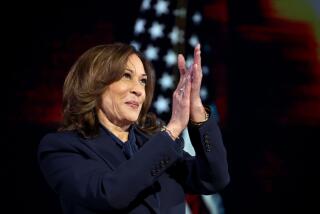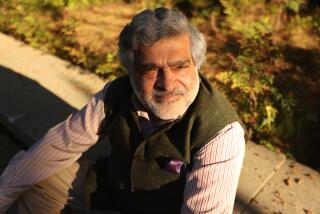Douglass, Not Lincoln, Bolsters GOP
- Share via
There is hardly a soul in American politics nowadays who will not pledge allegiance to the politics of inclusion. But to those who have long felt excluded, the burden of proof for tolerating diversity falls hardest on Republicans. President-elect George W. Bush has set the right tone, but his party is following the wrong model.
Republicans invoked Abraham Lincoln often this past year as their idea of the cornerstone of a politics of inclusion. “The party of Lincoln has not always carried the mantle of Lincoln,” Bush admitted to the National Assn. for the Advancement of Colored People. On opening night of the Republican National Convention, which centered on the theme of inclusion, Colin L. Powell, the secretary-of-State-in-waiting, confirmed that Bush “wants the Republican Party to wear Lincoln’s mantle again. But he knows it will take hard work.”
Early in the primaries, when he was running against Bush, Arizona Sen. John McCain declaimed that “the Republicans are the party of Abraham Lincoln, not Bob Jones.” McCain had to make this distinction because Bush had cozied up to segregationists in South Carolina.
Let’s talk straight. Is Lincoln’s mantle the answer to the Republicans’ diversity problem? In “Forced Into Glory,” his recent biography of the “Great Emancipator,” historian Lerone Bennett Jr. argues that Lincoln was a racist. Which, strictly speaking, is true. It is also true that Lincoln was deeply committed to abolishing slavery. Yet his proposed solution to the American dilemma was to ship people of African descent back to Africa.
While Republicans are rethinking inclusion, the new Bush administration should read Frederick Douglass’ “Oration in Memory of Abraham Lincoln,” given at the unveiling of the Freedman’s Monument in Washington in 1876. Douglass honored Lincoln as “the first martyr president of the U.S.,” but rejected the Great Emancipator myth. “Lincoln was not either our man or our model,” Douglass said. “He was preeminently the white man’s president, entirely devoted to the welfare of white men. You, my white fellow citizens, are the children of Abraham Lincoln. We are at best only his step children.”
If Republicans are looking for inclusive political symbols, then a glance in the rear view mirror at Lincoln is a good move, back to the days when the Republicans were an antislavery party. But let’s give credit where credit is due: to Frederick Douglass, the man who helped convince Lincoln that the Civil War was about destroying slavery; the man, who, as a Republican loyalist for almost half a century, most clearly articulated a critique of American racialism, but also a more attractive alternative: what Nelson Mandela has called nonracial democracy.
In “The Next American Nation,” Michael Lind calls Douglass” the greatest American” who deserves a monument as grand as those of our slave-holding forefathers. Having studied Douglass’ life and times over many years, I agree that he is that important. Douglass has too often been “ghettoized” within a black box, but he is a great American precisely because he was part of a social movement that transcended the barriers of race, religion and gender.
Douglass is best-known as an anti-slavery crusader, an abolitionist. Yet he was also a key proponent of women’s rights. He was a close friend and collaborator of many 19th-century feminists, such as Susan B. Anthony and Lydia Maria Child. The masthead of his newspaper, the North Star, proclaimed: “Right is of no sex, truth is of no color.”
Douglass was born into slavery in Maryland in 1818, to an Anglo father he never knew. He escaped North in 1838. And although he never went to school, he quickly became one of the nation’s most charismatic speakers. Douglass was the equivalent of a pop star--both a freedom fighter and a sex symbol over whom women of all classes and colors swooned.
Abolitionism was an international and multiethnic movement, and Douglass was its superstar. His speeches were reprinted in the pages of the major newspapers of his day. From this stage, he articulated a new vision of who was to participate in a more inclusive American “we.” Just as historian Taylor Branch refers to the 1950s and 1960s as “the King years,” because Martin Luther King Jr. most clearly gave voice to a more inclusive vision of political community, I believe we can also accurately speak of the mid-19th century as “the Douglass years.”
It is Douglass, rather than Lincoln, who represents the Republicans’ most inclusive legacy. Douglass understood that what Cuban patriot Jose Marti called “nuestra America”--our America--must be nonracial and hemispheric. Douglass put his words into practice, marrying an Anglo feminist and serving as a diplomat in Haiti and the Dominican Republic. Yet Douglass was not only a radical egalitarian, but also a cultural conservative, whose ideology of self-reliance should appeal to many Americans today.
I call Douglass an “integrative ancestor,” who can be claimed by people of many backgrounds. What he had to say has much relevance for the political, educational and cultural problems that still bedevil us. Above all, he is a model of how to build coalitions based on something other than the language of race. As an iconic figure, Douglass consistently challenged people’s racial stereotypes. In 1886, he told an audience: “[A man painting me insisted I show] my full face, for that is Ethiopian. Take my side face, said I, for that is Caucasian. But should you try my quarter face you would find it Indian. I don’t know that any race can claim me, but being identified with slaves as I am, I think I know the meaning of the inquiry.”
Douglass’ public persona was that of a defender of the rights of Afro-Americans. But his private identity was multiethnic. Douglass saw himself as an interracial mediator, whose “mission in life” was to “break down the walls between the races.” He believed that his multiethnic identity and community were not abnormal, but rather represented the future of America.
Douglass understood that racialism, “the insidious confusion of race with culture that haunts this society,” in the words of novelist Ralph Ellison, was the root cause of racism, and is a problem perpetuated by people of all colors. Douglass called racialism “diseased imagination.” If it could not be cured, it could be contained by presenting a more attractive alternative. Americans have still not learned this lesson. Most of us recognize that racism is wrong. But we try to cure the disease with the same poison, more racialism.
Inclusion without racialism. That may be a hard message to swallow for those who have made careers out of racial guilt, or racial victimization. But if Republicans follow the lead of the Douglass wing of the Republican Party, they will find that they can speak with moral authority and historical legitimacy.
More to Read
Get the L.A. Times Politics newsletter
Deeply reported insights into legislation, politics and policy from Sacramento, Washington and beyond. In your inbox three times per week.
You may occasionally receive promotional content from the Los Angeles Times.










